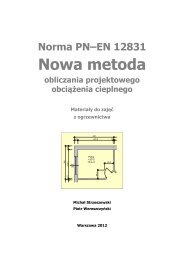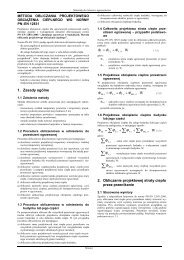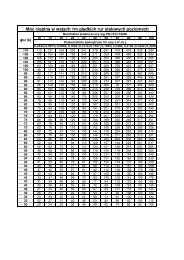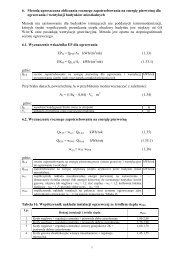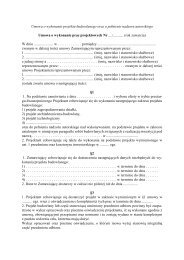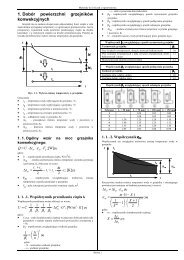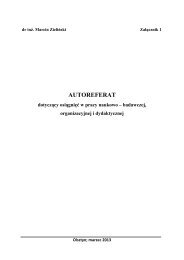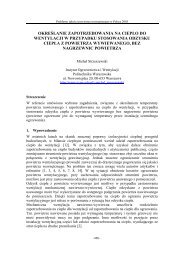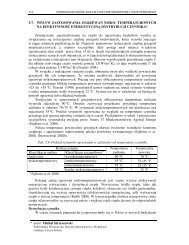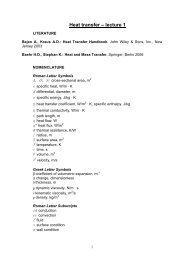English Summary of the PhD Thesis - WydziaÅ Inżynierii Årodowiska
English Summary of the PhD Thesis - WydziaÅ Inżynierii Årodowiska
English Summary of the PhD Thesis - WydziaÅ Inżynierii Årodowiska
Create successful ePaper yourself
Turn your PDF publications into a flip-book with our unique Google optimized e-Paper software.
Model obliczeniowy ogrzewań mikroprzewodowych 3W ramach badań doświadczalnych wyznaczono również opór cieplny peszla.W badanym przypadku (średnica zewnętrzna peszla d z =20,7 mm; średnice przewodówd z =12,0 mm/d w =8,4 mm) opór cieplny zastosowanego peszla wraz z pustką powietrznąustalono jako 0,59 mK/W, a zastępczy współczynnik przewodzenia ciepła 0,146 W/mK.Rozdział 9. zawiera badania symulacyjne przewodów pojedynczych i par przewodów,prowadzonych w konstrukcji stropu. Badania przeprowadzono przy użyciu zweryfikowanegodoświadczalnie modelu. Przeanalizowano wpływ na warunki wymiany ciepłanastępujących czynników: temperatura wody, rozstaw przewodów, grubość warstwy betonunad przewodami, grubość izolacji i prędkość wody.Rozdział 10. przedstawia przykładowe aplikacje niniejszej pracy i modelu wymianyciepła, zrealizowanego w postaci programu Micro 2D. Porównano w nim straty ciepłaprzewodów c.o., umieszczonych w podłodze, z mocą grzejnika konwekcyjnego.W drugiej części rozdziału wyznaczono sprawności izolacji przewodów w podłodzei odniesiono się do dotychczasowych praktyk projektowych. W ostatniej części rozdziałuwyznaczono, dla przykładowego sposobu prowadzenia przewodów, maksymalnątemperaturę zasilania, tak aby nie została przekroczona dopuszczalna temperatura powierzchnipodłogi. W omawianym przypadku maksymalne temperatury wody to60/40°C (dla temperatury dopuszczalnej 29°C) i 70/50°C (dla temperatury dopuszczalnej31°C).W rozdziale 11. zamieszczono podsumowanie i wnioski.Do pracy dołączono skróconą instrukcję obsługi programu komputerowego Micro 2D(Załącznik 1), przykładowy plik z danymi (Załącznik 2) oraz fragment plikuz wynikami (Załącznik 3).
Model obliczeniowy ogrzewań mikroprzewodowych 42. <strong>English</strong> <strong>Summary</strong>Micropipe heating systems belong to <strong>the</strong> low- or medium-temperature systems. Chapter4 presents <strong>the</strong>oretical basis <strong>of</strong> low-temperature heating systems. Application <strong>of</strong>those systems enables reduction <strong>of</strong> energy and exergy consumption. Beside that o<strong>the</strong>rbenefits may occur, such as improvement <strong>of</strong> <strong>the</strong>rmal comfort and improvement <strong>of</strong> interiorair quality. Additionally low-temperature radiator have “self-control properties”.Chapter 5 contains characteristic <strong>of</strong> micropipe heating systems. These systems are veryattractive for investors and users. But <strong>the</strong>ir proper work depends on <strong>the</strong> correct designand realization. This chapter presents also requirements for <strong>the</strong> temperature <strong>of</strong> <strong>the</strong> floorsurface.Simplified methods for determining heat losses from <strong>the</strong> pipes put in a slab are presentedin Chapter 6.The ma<strong>the</strong>matical model <strong>of</strong> <strong>the</strong> heat exchange for <strong>the</strong> pipes put in <strong>the</strong> floor or <strong>the</strong> wall isdescribed in Chapter 7. This chapter presents also <strong>the</strong> computer program Micro 2D(Figure 1.1), which implements <strong>the</strong> model.Chapter 8 includes also description <strong>of</strong> <strong>the</strong> research installation (Figure 1.2) and empiricalverification <strong>of</strong> <strong>the</strong> ma<strong>the</strong>matical model. The results obtained from <strong>the</strong> model correlatedto a large degree with those from physical measurements.Additionally <strong>the</strong> heat resistance <strong>of</strong> <strong>the</strong> protective g<strong>of</strong>fered pipe toge<strong>the</strong>r with <strong>the</strong> air voidwas determined empirically. For <strong>the</strong> examined case <strong>of</strong> (external diameter <strong>of</strong> <strong>the</strong> protectivepipe 20.7 mm, external diameter <strong>of</strong> <strong>the</strong> water pipe 12.0 mm and internal diameter<strong>the</strong> pipe 8.4 mm) <strong>the</strong> linear heat resistance was 0.59 mK/W and <strong>the</strong> substitute conductivitycoefficient was 0.146 W/mKChapter 9 presents <strong>the</strong> results <strong>of</strong> <strong>the</strong> computer simulation analyses for <strong>the</strong> singularpipes and <strong>the</strong> pairs <strong>of</strong> pipes. The research was carried out with <strong>the</strong> empirically verifiedcomputer program. The following factors were included in <strong>the</strong> analysis: water temperature,distance between <strong>the</strong> pipes, thickness <strong>of</strong> <strong>the</strong> concrete layer, thickness <strong>of</strong> <strong>the</strong> isolationand water velocity.
Model obliczeniowy ogrzewań mikroprzewodowych 5Chapter 10 shows <strong>the</strong> examples <strong>of</strong> <strong>the</strong> practical application <strong>of</strong> <strong>the</strong> study and <strong>the</strong> developedcomputer program Micro 2D:– comparison <strong>of</strong> <strong>the</strong> heat losses with <strong>the</strong> power <strong>of</strong> <strong>the</strong> radiator,– determination <strong>of</strong> <strong>the</strong> insulation efficiency for <strong>the</strong> pipes put in a floor,– determination <strong>of</strong> <strong>the</strong> maximal water temperature, so that <strong>the</strong> floor surface temperaturedoes not exceed <strong>the</strong> permissible value – for <strong>the</strong> analyzed case it is60/40°C (for permissible value <strong>of</strong> 29°C) and 70/50°C (for permissible value31°C).Chapter 11 includes <strong>the</strong> summary and conclusions.Appendix 1 contains <strong>the</strong> shortened version <strong>of</strong> <strong>the</strong> manual for <strong>the</strong> computer program Micro2D. Appendix 2 shows an exemplary data file and Appendix 3 – fragments <strong>of</strong> anexemplary results file.



